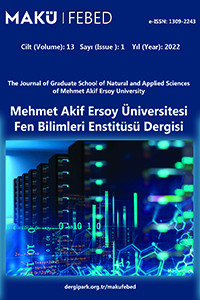Perovskit Güneş Hücreleri ve Kararsızlık Problemleri
Perovskit güneş hücreleri, Kararsızlık problemi, Spin kaplama tekniği, Termal buharlaştırma tekniği, İki adımlı daldırarak kaplama tekniği, İki adımlı daldırarak kaplama tekniği
Perovskite Solar Cells and Instability Problems
Perovskite solar cells, Instability problem, Spin coating technique, Thermal evaporation technique, Two step dip coating technique,
___
- Bednorz, J. G. and K. A. Müller. 1986. “Possible High T c Superconductivity in the Ba — La — Cu — O System.” 193:267–71. Retrieved (http://link.springer.com/10.1007/978-94-011-1622-0_32).Bella, Federico, Claudio Gerbaldi, Claudia Barolo, and Michael Grätzel. 2015. “Aqueous Dye-Sensitized Solar Cells.” Chem. Soc. Rev. 44(11):3431–73. Retrieved (http://xlink.rsc.org/?DOI=C4CS00456F).
- Bi, Cheng et al. 2014. “Understanding the Formation and Evolution of Interdiffusion Grown Organolead Halide Perovskite Thin Films by Thermal Annealing.” J. Mater. Chem. A 2(43):18508–14. Retrieved (http://xlink.rsc.org/?DOI=C4TA04007D).
- Bisquert, Juan et al. 2008. “A Review of Recent Results on Electrochemical Determination of the Density of Electronic States of Nanostructured Metal-Oxide Semiconductors and Organic Hole Conductors.” Inorganica Chimica Acta 361(3):684–98.
- Christians, Jeffrey A., Pierre A. Miranda Herrera, and Prashant V. Kamat. 2015. “Transformation of the Excited State and Photovoltaic Efficiency of CH3NH3PbI3 Perovskite upon Controlled Exposure to Humidified Air.” Journal of the American Chemical Society 137(4):1530–38.
- Etgar, Lioz et al. 2012. “Mesoscopic CH 3 NH 3 PbI 3 /TiO 2 Heterojunction Solar Cells.” Journal of the American Chemical Society 134(42):17396–99. Retrieved (http://pubs.acs.org/doi/10.1021/ja307789s).
- Frost, Jarvist M. et al. 2014. “Atomistic Origins of High-Performance in Hybrid Halide Perovskite Solar Cells.” Nano Letters 14(5):2584–90. Retrieved (http://pubs.acs.org/doi/10.1021/nl500390f).
- Green, Martin A. et al. 2018. “Solar Cell Efficiency Tables (Version 51).” Progress in Photovoltaics: Research and Applications 26(1):3–12.
- Green, Martin A., Keith Emery, Yoshihiro Hishikawa, Wilhelm Warta, and Ewan D. Dunlop. 2015. “Solar Cell Efficiency Tables (Version 45).” Progress in Photovoltaics: Research and Applications 23(1):1–9. Retrieved (http://doi.wiley.com/10.1002/pip.2573).
- Green, Martin A., Anita Ho-Baillie, and Henry J. Snaith. 2014. “The Emergence of Perovskite Solar Cells.” Nature Photonics 8(7):506–14. Retrieved (http://www.nature.com/articles/nphoton.2014.134).
- Hinsch, A. et al. 2001. “Long-Term Stability of Dye-Sensitised Solar Cells.” Progress in Photovoltaics: Research and Applications 9(6):425–38.
- Im, Jeong-Hyeok, Chang-Ryul Lee, Jin-Wook Lee, Sang-Won Park, and Nam-Gyu Park. 2011a. “6.5% Efficient Perovskite Quantum-Dot-Sensitized Solar Cell.” Nanoscale 3(10):4088. Retrieved (http://xlink.rsc.org/?DOI=c1nr10867k).
- Jeon, Nam Joong et al. 2015. “Compositional Engineering of Perovskite Materials for High-Performance Solar Cells.” Nature 517(7535):476–80. Retrieved (http://dx.doi.org/10.1038/nature14133).
- Jørgensen, Mikkel, Kion Norrman, and Frederik C. Krebs. 2008. “Stability/Degradation of Polymer Solar Cells.” Solar Energy Materials and Solar Cells 92(7):686–714.
- Kim, Hui Seon et al. 2012. “Lead Iodide Perovskite Sensitized All-Solid-State Submicron Thin Film Mesoscopic Solar Cell with Efficiency Exceeding 9%.” Scientific Reports 2:1–7.
- Kojima, Akihiro, Kenjiro Teshima, Yasuo Shirai, and Tsutomu Miyasaka. 2009. “Organometal Halide Perovskites as Visible-Light Sensitizers for Photovoltaic Cells.” Journal of the American Chemical Society 131(17):6050–51. Retrieved (http://pubs.acs.org/doi/abs/10.1021/ja809598r).
- Lee, Jin-Wook and Nam-Gyu Park. 2015. “Two-Step Deposition Method for High-Efficiency Perovskite Solar Cells.” MRS Bulletin 40(August):654.
- Lee, M. M., J. Teuscher, T. Miyasaka, T. N. Murakami, and H. J. Snaith. 2012. “Efficient Hybrid Solar Cells Based on Meso-Superstructured Organometal Halide Perovskites.” Science 338(6107):643–47. Retrieved (http://www.sciencemag.org/cgi/doi/10.1126/science.1225053).
- Leijtens, Tomas et al. 2013. “Overcoming Ultraviolet Light Instability of Sensitized TiO2 with Meso-Superstructured Organometal Tri-Halide Perovskite Solar Cells.” Nature Communications 4:1–8. Retrieved (http://www.nature.com/doifinder/10.1038/ncomms3885).
- Liu, Mingzhen, Michael B. Johnston, and Henry J. Snaith. 2013. “Efficient Planar Heterojunction Perovskite Solar Cells by Vapour Deposition.” Nature 501(7467):395–98. Retrieved (http://dx.doi.org/10.1038/nature12509).
- Mei, Anyi et al. 2014. “A Hole-Conductor-Free, Fully Printable Mesoscopic Perovskite Solar Cell with High Stability.” Science 345(6194):295–98. Retrieved (http://www.sciencemag.org/cgi/doi/10.1126/science.1254763).
- Mitzi, D. B., C. A. Feild, W. T. A. Harrison, and A. M. Guloy. 1994. “Conducting Tin Halides with a Layered Organic-Based Perovskite Structure.” Nature 369(6480):467–69. Retrieved (http://www.nature.com/doifinder/10.1038/369467a0).
- Mitzi, David B. 2001. “Thin-Film Deposition of Organic−Inorganic Hybrid Materials.” Chemistry of Materials 13(10):3283–98. Retrieved (http://pubs.acs.org/doi/abs/10.1021/cm0101677).
- Noh, Jun Hong, Sang Hyuk Im, Jin Hyuck Heo, Tarak N. Mandal, and Sang Il Seok. 2013. “Chemical Management for Colorful, Efficient, and Stable Inorganic–Organic Hybrid Nanostructured Solar Cells.” Nano Letters 13(4):1764–69. Retrieved (http://pubs.acs.org/doi/10.1021/nl400349b).
- Salado, Manuel et al. 2017. “Impact of Moisture on Efficiency-Determining Electronic Processes in Perovskite Solar Cells.” J. Mater. Chem. A 5(22):10917–27. Retrieved (http://xlink.rsc.org/?DOI=C7TA02264F).
- Schwanitz, Konrad, Ulrich Weiler, Ralf Hunger, Thomas Mayer, and Wolfram Jaegermann. 2007. “Synchrotron-Induced Photoelectron Spectroscopy of the Dye-Sensitized Nanocrystalline TiO 2 /Electrolyte Interface: Band Gap States and Their Interaction with Dye and Solvent Molecules.” The Journal of Physical Chemistry C 111(2):849–54. Retrieved (http://pubs.acs.org/doi/abs/10.1021/jp064689r).
- Suarez, Belen et al. 2014. “Supporting Information: Recombination Study of Combined Halides (Cl, Br, I) Perovskite Solar Cells.” J. Phys. Chem. Lett. 5(10):1628–35. Retrieved (http://pubs.acs.org/doi/abs/10.1021/jz5006797).
- Xing, Guichuan et al. 2013. “Long-Range Balanced Electron- and Hole-Transport Lengths in Organic-Inorganic CH3NH3PbI3.” Science 342(6156):344–47. Retrieved (http://www.sciencemag.org/cgi/doi/10.1126/science.1243167).
- Yang, Jinli, Braden D. Siempelkamp, Dianyi Liu, and Timothy L. Kelly. 2015. “Investigation of CH3NH3PbI3degradation Rates and Mechanisms in Controlled Humidity Environments Using in Situ Techniques.” ACS Nano 9(2):1955–63.
- Zhihua Xu, Kevin Weeks, Taryn De Rosia. n.d. “Perovskite Solar Cells.” Retrieved (https://pdfs.semanticscholar.org/presentation/928b/f102a912a067a6361ebb6bbdf983b2df7af8.pdf).
- Zhou, Huawei et al. 2014. “Hole-Conductor-Free, Metal-Electrode-Free TiO 2 /CH 3 NH 3 PbI 3 Heterojunction Solar Cells Based on a Low-Temperature Carbon Electrode.” The Journal of Physical Chemistry Letters 5(18):3241–46. Retrieved (http://pubs.acs.org/doi/10.1021/jz5017069).
- Yayın Aralığı: Yılda 2 Sayı
- Başlangıç: 2010
- Yayıncı: Burdur Mehmet Akif Ersoy Üniversitesi
Bülent URUL, Habib DOĞAN, Bilal TÜTÜNCÜ, Selçuk HELHEL
Antalya Havzası Akarsularındaki Yılan balığı Göçleri Üzerine Antropojenik Baskılar
Fahrettin KÜÇÜK, İskender GÜLLE, Salim Serkan GÜÇLÜ
Perovskit Güneş Hücreleri ve Kararsızlık Problemleri
Kent Ormancılığı Faaliyetlerinin Sürdürülmesi: Çivril, Denizli Örneği
Cengiz YÜCEDAĞ, Latif Gürkan KAYA, Hüseyin Samet AŞIKKUTLU, Eşe SAĞIR
Kent Kimliğinin Kent Meydanlarına Yansıması: Alanya İskele-Rıhtım Bölgesi Örneği
Ali TÜRK, Hatice Selcen SEYDİOĞULLARI
Pawlak Yaklaşım Uzaylarının Topolojik Yapısı ve Genelleştirilmiş Kaba Kümeler
Türkiye'deki Mevcut Betonarme Binaların Deprem Performansları Üzerine Bir Değerlendirme
Hakan DİLMAÇ, Hakan ULUTAŞ, Hamide TEKELİ, Fuat DEMİR
Orhan GÜNGÖR, Hüseyin Bilal MACİT, Abdülkadir ÇAKIR
Bakır Folyo Kaplı Yönlendirilmiş Yonga Levhanın Elektromanyetik Girişimi Soğurma Etkinliği
